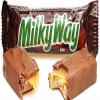First, I would double check whether a navmesh is the best solution in this scenario. They are really cool, but in a really large world, particularly with repeating assets (i.e. lots of clones of similar artwork), there might be other approaches that work well, such as simply bounding volumes around the obstacles. A lot depends on the details of your game though. Is it an RPG with trees to avoid, or a game like grand theft auto with joined buildings etc..
If you want to have such a large world, one options is to think whether you can devise a hierarchical system of navigation / pathfinding. As an example, with a building with multiple rooms, you can only travel between the rooms via doors, so you can have one system for finding the way between rooms (via doors) and one system for finding your way *within* the room, via a navmesh or whatever. If you apply this to a big world, you have a compact and fast way for doing the high level pathfinding, then you can load local navmeshes as required, presolve local navmesh A stars etc.
For the sizes, you can 'push' the navmesh walls at runtime and take into account agent size in the connections, but most people seem to recommend just keeping several navmeshes at several preset agent sizes. Obviously with a huge navmesh the first option could potentially become more attractive.









